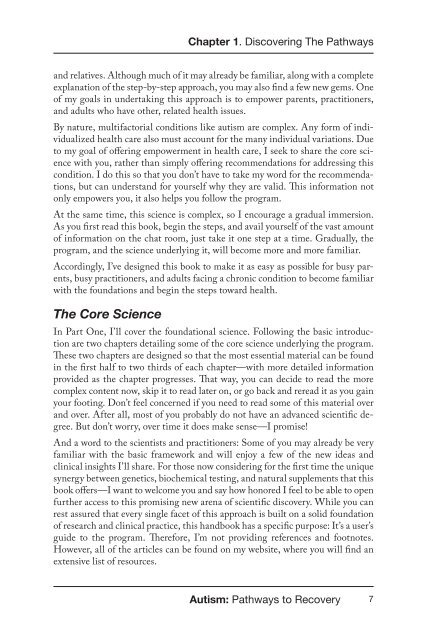3dT4E4Rnm
3dT4E4Rnm
3dT4E4Rnm
Create successful ePaper yourself
Turn your PDF publications into a flip-book with our unique Google optimized e-Paper software.
Chapter 1. Discovering The Pathways<br />
and relatives. Although much of it may already be familiar, along with a complete<br />
explanation of the step-by-step approach, you may also find a few new gems. One<br />
of my goals in undertaking this approach is to empower parents, practitioners,<br />
and adults who have other, related health issues.<br />
By nature, multifactorial conditions like autism are complex. Any form of individualized<br />
health care also must account for the many individual variations. Due<br />
to my goal of offering empowerment in health care, I seek to share the core science<br />
with you, rather than simply offering recommendations for addressing this<br />
condition. I do this so that you don’t have to take my word for the recommendations,<br />
but can understand for yourself why they are valid. This information not<br />
only empowers you, it also helps you follow the program.<br />
At the same time, this science is complex, so I encourage a gradual immersion.<br />
As you first read this book, begin the steps, and avail yourself of the vast amount<br />
of information on the chat room, just take it one step at a time. Gradually, the<br />
program, and the science underlying it, will become more and more familiar.<br />
Accordingly, I’ve designed this book to make it as easy as possible for busy parents,<br />
busy practitioners, and adults facing a chronic condition to become familiar<br />
with the foundations and begin the steps toward health.<br />
The Core Science<br />
In Part One, I’ll cover the foundational science. Following the basic introduction<br />
are two chapters detailing some of the core science underlying the program.<br />
These two chapters are designed so that the most essential material can be found<br />
in the first half to two thirds of each chapter—with more detailed information<br />
provided as the chapter progresses. That way, you can decide to read the more<br />
complex content now, skip it to read later on, or go back and reread it as you gain<br />
your footing. Don’t feel concerned if you need to read some of this material over<br />
and over. After all, most of you probably do not have an advanced scientific degree.<br />
But don’t worry, over time it does make sense—I promise!<br />
And a word to the scientists and practitioners: Some of you may already be very<br />
familiar with the basic framework and will enjoy a few of the new ideas and<br />
clinical insights I’ll share. For those now considering for the first time the unique<br />
synergy between genetics, biochemical testing, and natural supplements that this<br />
book offers—I want to welcome you and say how honored I feel to be able to open<br />
further access to this promising new arena of scientific discovery. While you can<br />
rest assured that every single facet of this approach is built on a solid foundation<br />
of research and clinical practice, this handbook has a specific purpose: It’s a user’s<br />
guide to the program. Therefore, I’m not providing references and footnotes.<br />
However, all of the articles can be found on my website, where you will find an<br />
extensive list of resources.<br />
Autism: Pathways to Recovery<br />
7


